7 Unique Experiences in Nepal
Whether it's supporting local communities or opting for eco-friendly practices, responsible travel plays a vital role in ensuring that Nepal's splendor remains untouched for generations to come.
Whether it's supporting local communities or opting for eco-friendly practices, responsible travel plays a vital role in ensuring that Nepal's splendor remains untouched for generations to come.

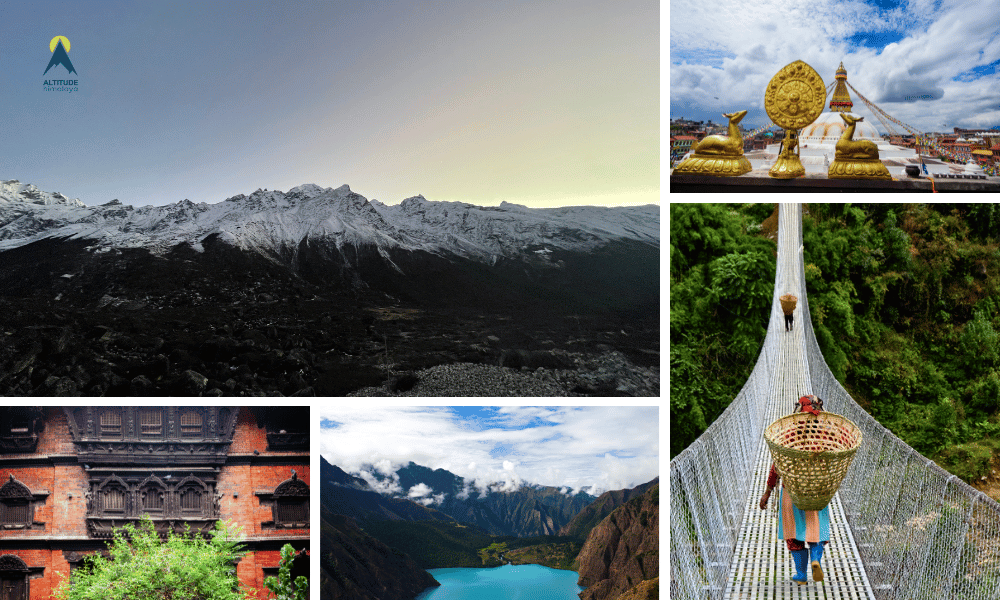
Nepal is where majestic mountains stand tall amidst vibrant cultures, creating a tapestry of wonder and adventure. In this blog, you will find yourself in the heart and soul of Nepal, where hidden gems and offbeat wonders await your discovery. From soaring peaks to ancient traditions, Nepal has something extraordinary to offer every traveler, and we can’t wait to share it all with you.
It’s the start of your day and the sun illuminating the mighty Himalayas on an exhilarating Everest Base Camp Helicopter Tour. As you rise above the world's highest peaks, including Mount Everest, prepare to be awe-inspired by jaw-dropping aerial views. But Nepal's uniqueness doesn't stop there! Harvesting wild honey from cliffside beehives using traditional rope ladders not just gives you an adrenaline high but it connects you to the hidden cultural heritages of Nepal. The cultural significance of Honey Hunting in the local community adds a heartwarming touch to this exhilarating experience.
Wildlife enthusiasts can get ready for a rendezvous with the untamed side of Nepal in Bardiya National Park. Embark on thrilling Tiger Tracking safaris through lush forests and grasslands, where the elusive Bengal tiger and other exotic creatures roam freely. Each moment in the wild will bring you closer to the heart of Nepal's diverse ecosystem. Guided by expert naturalists, you'll gain insights into the delicate balance of nature and the conservation efforts to protect Nepal's precious wildlife. With every sighting of these magnificent animals, you'll feel a deep sense of appreciation for the beauty and complexity of life in the wild.
For the intrepid souls seeking the road less traveled, a journey to Upper Dolpo promises encounters with the rare and elusive snow leopard. With experienced guides leading the way, Snow Leopard Tracking unveils a world of rugged landscapes and heartwarming wildlife sightings. Patience becomes your ally as you await a glimpse of these majestic creatures in their natural habitat. But beyond the excitement of the hunt, it's an opportunity to immerse yourself in the serenity of the Himalayas and reflect on the importance of wildlife conservation.
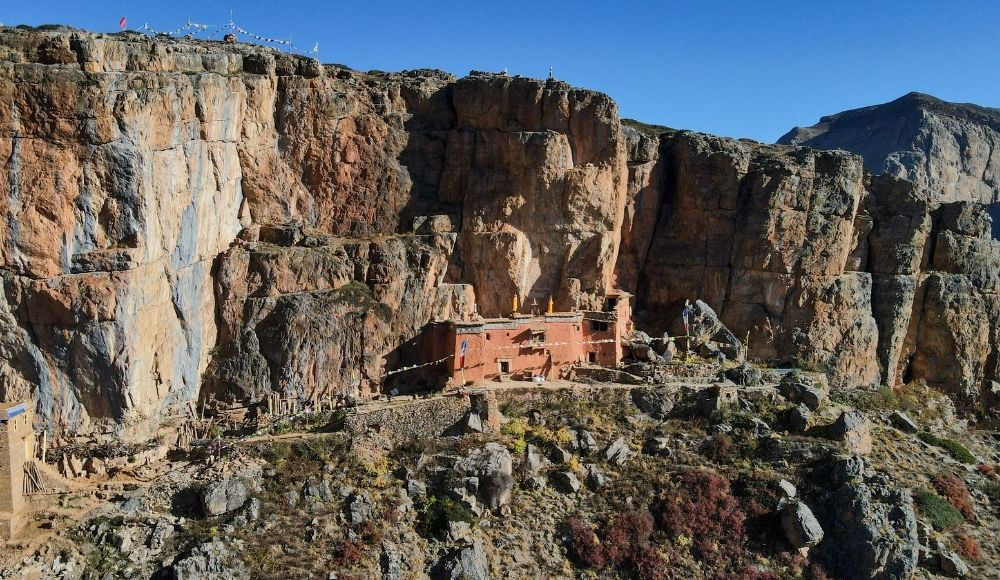
As we delve deeper into the mountains, you can even immerse yourself in the Gathering of Yarsagumba. Join the locals in the search for this valuable caterpillar fungus, prized for its medicinal properties. Beyond the economic value, Yarsagumba holds cultural significance, intertwining with the way of life of the mountain communities. However, as the demand for this "Himalayan Viagra" increases, it raises concerns about sustainability and its impact on the fragile ecosystem. As responsible travelers, it will fall upon you as well to ensure the delicate balance of nature is preserved for generations to come.
Back in the heart of Kathmandu, you can experience the exuberant Indra Jatra Celebration. Along many other things, you can join the lively processions, witness masked dances, and immerse yourself in the cultural fervor of this joyous festival. As you mingle with locals and embrace the festive spirit, you'll feel a sense of camaraderie that transcends cultural barriers. The joyous energy of Indra Jatra will leave you with cherished memories and a deeper understanding of Nepal and its people.
And what's a journey without indulging in the flavors of the land? Food Exploration in Nepal promises a culinary adventure like no other. From the beloved momo to dhindo and Sel roti, each dish is a delightful exploration of Nepal's diverse culinary traditions. The blending of aromatic spices and fresh local ingredients creates a symphony of flavors that will tantalize your taste buds. As you savor each dish, you'll discover that food truly is a universal language that brings people together.
Throughout your exploration, you can venture off the beaten path to treasures like Bandipur, Mustang, and Rara Lake. As we traverse Nepal's diverse landscape, we'll emphasize the importance of responsible travel, respecting local customs, and preserving the natural beauty of this extraordinary country. Whether it's supporting local communities or opting for eco-friendly practices, responsible travel plays a vital role in ensuring that Nepal's splendor remains untouched for generations to come. Together, let's embark on this remarkable expedition, where each chapter reveals a unique facet of Nepal, inviting you to immerse yourself in the wonders that await you.
|
Name: |
Everest Base Camp Helicopter Tour |
|
Duration: |
1 Day |
|
Route: |
Kathmandu-Everest Base Camp-Kathmandu |
|
Highlights of the tour: |
|
|
Best Time to Visit: |
Spring and Autumn Seasons |
|
Difficulty: |
Easy |
For every adventurer, the desire to stand at the pinnacle of the world is a bucket-list dream. Everest, the towering icon that touches the sky, has captured the imagination of countless souls. But let’s be real- not all of us are born trekkers. But that doesn’t mean we can’t experience the thrill of Everest. This heli tour is like your express pass to Everest Base Camp’s jaw-dropping views, minus the sweat and blisters.
The allure of Everest is undeniable, and reaching its mighty height is now more accessible than ever. The towering peak can be admired from various vantage points and hill stations across Nepal. Furthermore, heli services and mountain flights have become a vital conduit to Everest’s awe-inspiring presence.
The Mount Everest Helicopter Tour offers a swift and comfortable journey for those who lack the time for a two-week expedition. The adventure begins as a helicopter departs from Kathmandu, setting on a scenic flight toward Everest. The aerial vistas en route set the stage for an extraordinary journey. As the helicopter hovers above the Everest region, it gradually descends to land either at Everest Base Camp or at Kala Patthar.
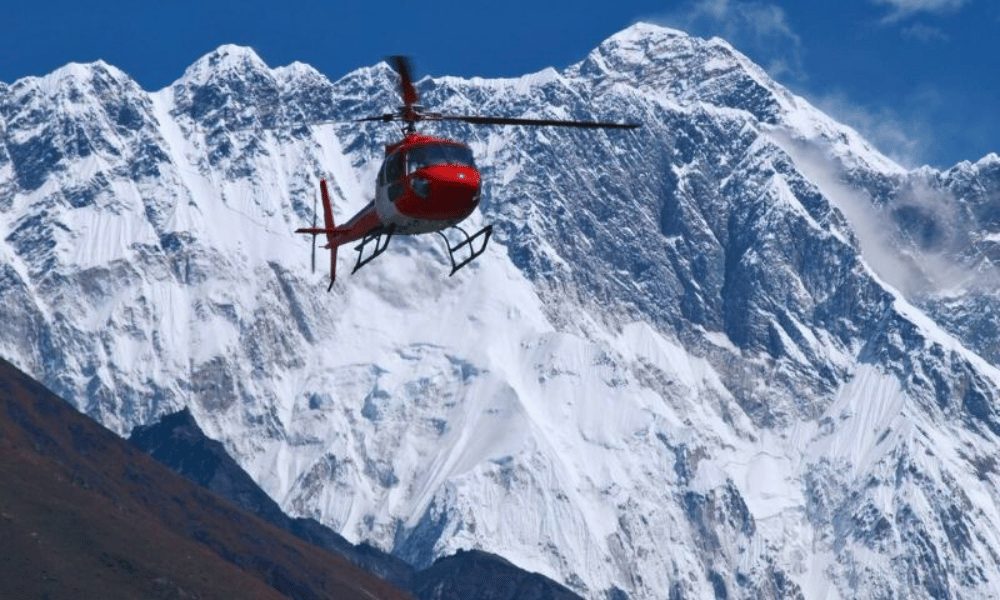
The Spring and Autumn seasons, known for clear skies and favorable weather, provide the optimal backdrop for Everest helicopter tours. The lush greenery, breathtaking landscapes, and Himalayan beauty are at their peak during these times. Although months from June to August present challenges due to monsoon rains, every other month offers an inviting canvas for an aerial adventure to Everest.
As the helicopter touches down at Mount Everest Base Camp, a world of wonder unfolds before you. The experience is immersive, allowing time to explore the surroundings, capture stunning photograph, and absorb the ambiance of this iconic location. However, the altitude requires preparation. Spending about an hour at the Base Camp requires warm clothing and hydration to fend off potential altitude sickness.
The Everest Base Camp Helicopter Tour concludes with a return flight to Kathmandu, stopping at Syangboche for a brief respite. The memories of this day will surely accompany you, etched in your heart as a testament to your journey above the clouds. Don't just dream of Everest; experience its magnificence from the skies and create memories that will forever resonate with the awe-inspiring beauty of the Himalayas.
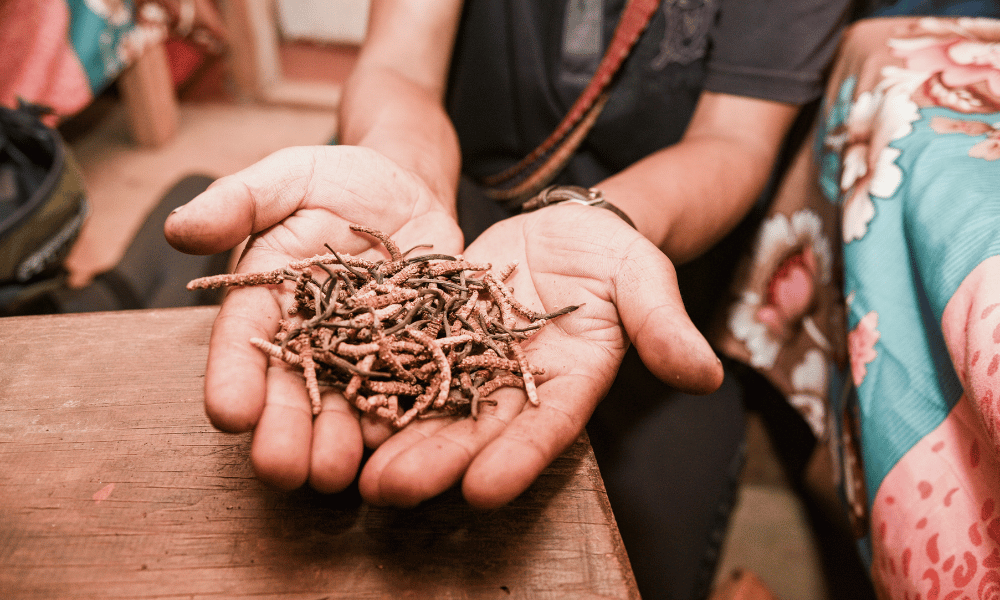
Imagine a treasure hunt that unfolds each year during May and June when the Himalayan regions come alive with the excitement of the Yarsagumba gathering – often dubbed the "Himalayan Gold Rush." Yarsagumba (Yarshagumba) is a remarkable medicinal fungus that thrives in high-altitude meadows above 3,500 meters, and its allure extends far beyond its unique health benefits. This age-old tradition has become an essential part of local culture, providing both economic sustenance and a deep-rooted connection to the land.
In the early 2000s, the trade of Yarsagumba faced a ban in Nepal, but it later found a regulated path to flourish through the payment of royalties. Since then, the 12 districts known for their high-altitude habitats, including Darchula, Dolpa, Jumla, and Mugu, have become bustling centers for this precious fungus. The craze of Yarsagumba extends far beyond Nepal's borders. Its high demand in countries like Korea, Taiwan, Hong Kong, and others has transformed it into a valuable export, making it an internationally sought-after herbal remedy.
Each year, as villagers ascend the Himalayan heights emptying villages, they carry with them the hopes and excitement of generations past and present. You can be a part of it as the Yarsagumba gathering is more than just a business venture; it's a way of life for the people of the Himalayas, a symbol of resilience and determination.
This herb also holds a sacred place in traditional Asian medicine, celebrated for its potential health benefits. As you become part of this adventure, you'll not only witness the gathering process but also connect with the people, culture, and natural beauty of the Himalayan regions. This experience encapsulates the heart and soul of a land where ancient practices and modern opportunities converge, where Yarsagumba becomes a bridge that spans generations and enriches lives, truly embodying the spirit of the Himalayas.
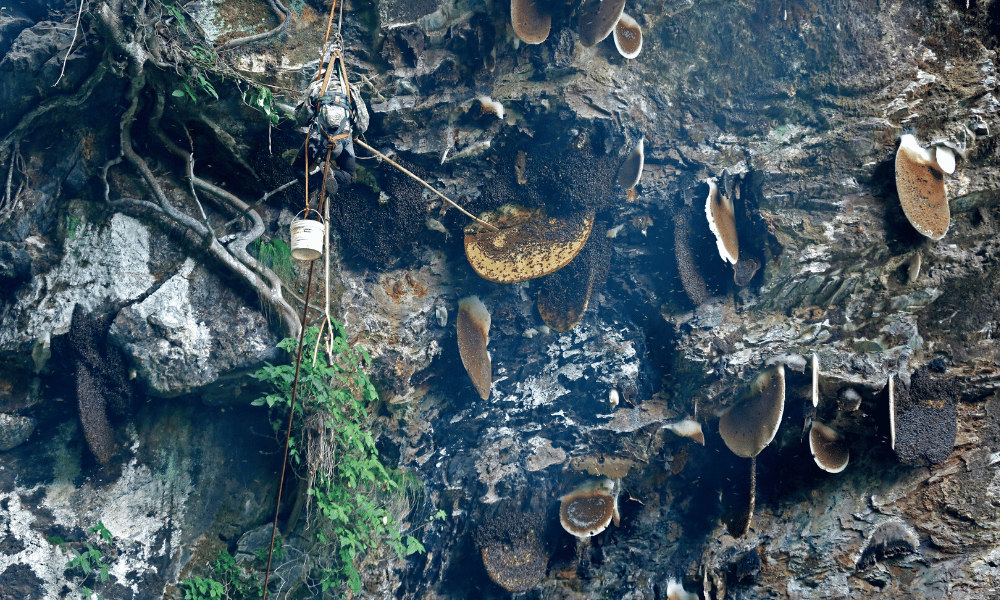
|
Name: |
Honey Hunting Tour |
|
Duration: |
5-7 Days |
|
Highlights of the tour: |
|
|
Difficulty: |
Easy to Moderate |
In the remote hills and mountains of Nepal, a timeless tradition takes place-Honey Hunting. This practice has been passed down through generations, connecting local communities and the environment they call home. The art of honey hunting is not just a skill; it’s a reflection of courage and mastery that defines this unique practice.
Scaling cliffs and confronting dizzying heights, honey hunters exhibit a remarkable blend of skill and fearlessness. Their centuries-old techniques have been refined over time, ensuring that this endures the passage of time and civilization. As you go to one of the areas popular for honey hunting (Ghanpokhara, Khudri, Taghring, Bulbule, Dudhpokhari areas of Lamjung), you will witness honey hunters with little to no safety equipment on their way to collect wild honey from the side of a cliff on a wobbly rope ladder. If you are daring enough, you can even request to be a part of it instead of just an observer.
Wild honey is more than a commodity; it's a lifeline for many honey-hunting communities. The harvest not only sustains them but also fuels local economies. From alleviating coughs and colds to aiding digestion, honey is a trusted remedy in Nepalese households. And let's not forget "mad honey" – a variety with psychoactive qualities, used for centuries in healing rituals and recreative activities. As eco-tourism gains traction, visitors from around the world are drawn to this ancient practice, offering a sustainable source of income while preserving a cultural treasure for generations to come.
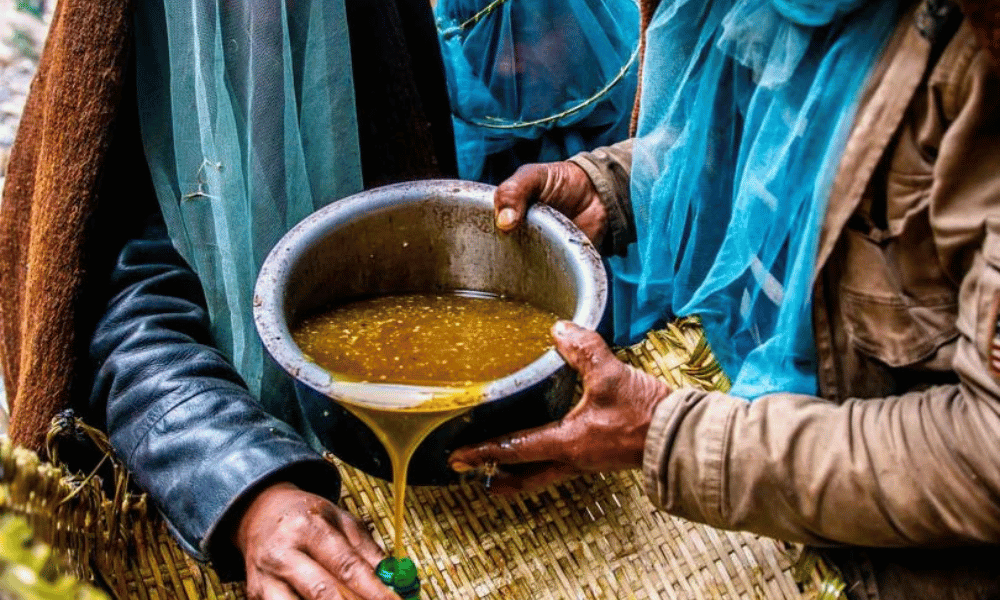
In a world often dominated by modernity, honey hunting stands as a bridge between past and present. It's a poignant reminder that traditions can endure, even in the face of change. As the honey hunters scale the heights, they echo the resilience of their communities and the endurance of their culture. So, if you're ready for a journey that's as enriching as it is exhilarating, venture into Nepal's hills and mountains – where mad honey echoes the bond between people and nature.
The diverse geography of Nepal, from the fertile plains to the towering Himalayas, contributes to the abundance of ingredients used in Nepali cuisine. The availability of locally grown produce, fragrant spices, and aromatic herbs ensures that each region's cuisine is deeply connected to its surroundings.
One of the most iconic dishes of Nepali cuisine is momo, a popular dumpling filled with a variety of ingredients, from succulent meat to flavorful vegetables. These tasty treats, often served with a side of tangy dipping sauce, have become a staple in Nepali street food and are a must-try for anyone visiting the bustling streets of Kathmandu. Momos are not unique to Nepal but the sheer variation we have of this simple dumpling will surely boggle your mind and tastebuds.
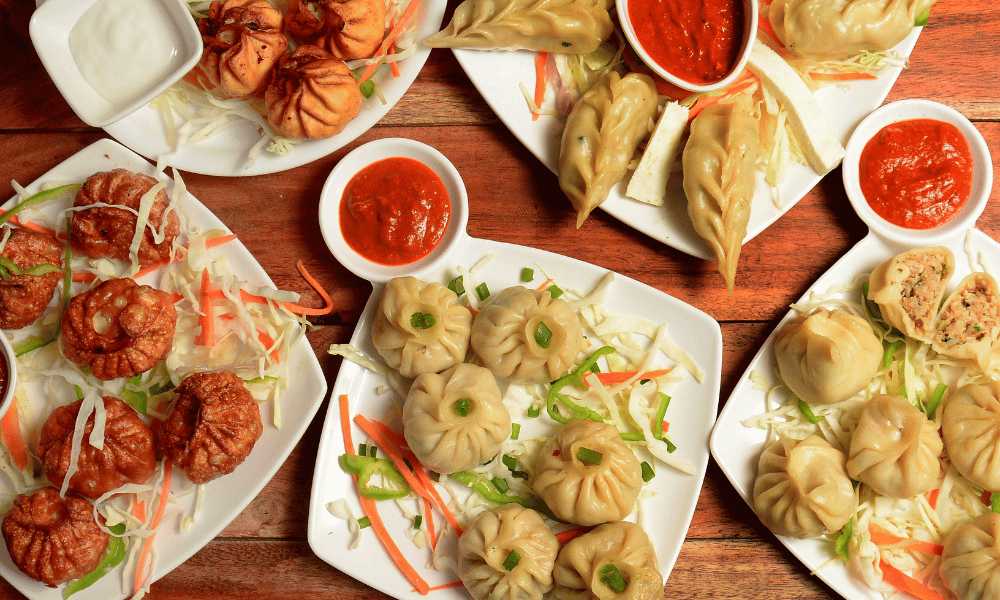
For a comforting start to your day, there's Sel roti, a crispy rice-based doughnut with a soft interior. Paired with a steaming cup of chai, it's a simple yet delightful treat. Likewise, Dhindo, a staple made from buckwheat or millet, is a traditional dish that is served alongside flavorful curries and pickles, originating in the highlands of Nepal where rice was not readily available.
As you explore Nepal's culinary landscape, be sure to savor the flavors of sekuwa, skewers of marinated meat grilled to perfection over an open flame. The tantalizing aroma and tender texture make sekuwa a popular choice, particularly for those seeking a taste of Nepali barbecue. You can try whatever meat you prefer and it’ll taste just as good.
And let's not forget samay baji, a traditional Newari dish. This assorted combination of beaten rice, lentil patties, and boiled eggs, among other ingredients, represents a huge chunk of Newari food culture. And if you are still looking for more foods to try, go for the festive special Kwati. A rich and flavorful soup made from nine different types of sprouted beans, Kwati is often enjoyed during special occasions, adding a festive touch to the dining experience.
In the highlands, you'll discover warming meals like thukpa and yak-based dishes, while in the Terai plains, flavors are often influenced by Indian cuisine, resulting in spicy delights such as aloo taama(potatoes and bamboo shoot curry) and biryani variants.
Nepali cuisine, as you might have already guessed, goes beyond these beloved dishes, as it varies significantly with communities, geography, and ethnicity. Each culture and area has its own staple dishes and drinks, reflecting the unique flavors and traditions of that region. From the aromatic dishes of the Newars in the Kathmandu Valley to the hearty meals of the Gurungs in the hilly regions, every community brings its distinct culinary identity to the table.
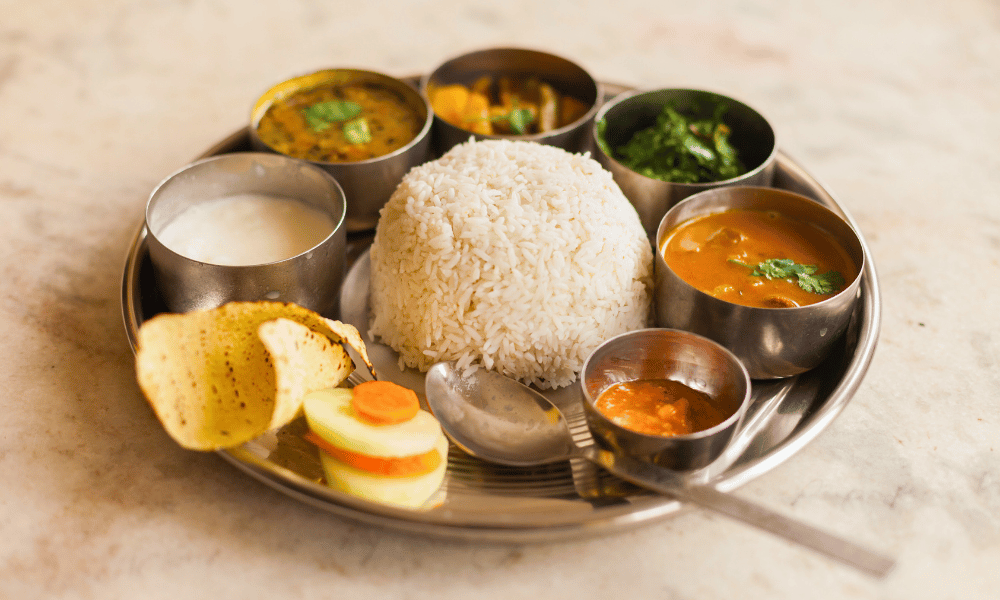
|
Name: |
Tiger Tracking in Bardia National Park |
|
Duration: |
7 Days |
|
Route: |
Kathmandu-Bardia-Kathmandu |
|
Highlights of the tour: |
|
|
Difficulty: |
Easy |
An unforgettable expedition that invites you to explore the untamed wilderness of Nepal: the Bardia Tiger Tracking tour. In addition to the incredible opportunity to observe the Royal Bengal Tiger in its natural environment, this expedition offers a deep dive into the vibrant Tharu culture and reveals the untouched splendor of the wilderness.
A key highlight of this adventure is a dusk jeep safari that takes you deep into the heart of the jungle. As you walk through the dense foliage, you are greeted by a diverse array of creatures that inhabit this ecosystem. With an experienced guide, you will have the opportunity to explore potential Tiger habitats and gain valuable insights into their behaviors. Spending a full day in the wilderness offers an exciting adventure and a deep insight into the mysterious Royal Bengal Tiger.
Another highlight of the trip is the river Safari, which provides an opportunity to cruise along the Karnali River. This adventure offers a distinctive viewpoint of the region's natural habitat. After crossing the river, the transition to a jeep safari provides an opportunity to encounter a wide range of wildlife thriving in the midst of the lush landscape.
![]()
You will get to experience a whole new dimension as you go a Tiger Tracking on Foot, expertly guided by a seasoned naturalist. While exploring uncharted routes, you will search for unique pugmarks and informative scats that indicate the presence of the elusive Tiger. The virtue of patience becomes evident as you eagerly anticipate the moment when the majestic Tiger emerges, creating a lasting memory of pure exhilaration.
Immerse yourself in the expertise of our guides and experience the tranquil ambiance of the jungle as you behold the breathtaking beauty and formidable strength of the Royal Bengal Tiger. At the end of each day, your resort greets you with cozy bonfires, creating the perfect atmosphere for reflection and celebration of an incredible journey.
The Bardia Tiger Tracking tour not only provides a mere glimpse into the wild but also offers a truly transformative experience that allows you to reconnect with the magnificent wonders of nature. This journey combines excitement and tranquility, showcasing the magnificent beauty of the Royal Bengal Tiger and the captivating allure of the Nepalese wilderness.
|
Name: |
Snow Leopard Tracking in Upper Dolpo |
|
Duration: |
10-15 Days |
|
Destination |
Upper Dolpo Region |
|
Highlights of the tour: |
|
|
Difficulty: |
Difficult |
What could possibly be more exciting than heading on a quest to encounter the Snow Leopard in the enchanting landscapes of Upper Dolpo? This adventure transcends traditional wildlife observation. Snow Leopard Tracking Tour is a tribute to the majestic beauty of this elusive creature, made possible with the help of field experts and dedicated conservationists. This is a chance to showcase their presence to the world, while also highlighting the vital importance of safeguarding their delicate habitat and population.
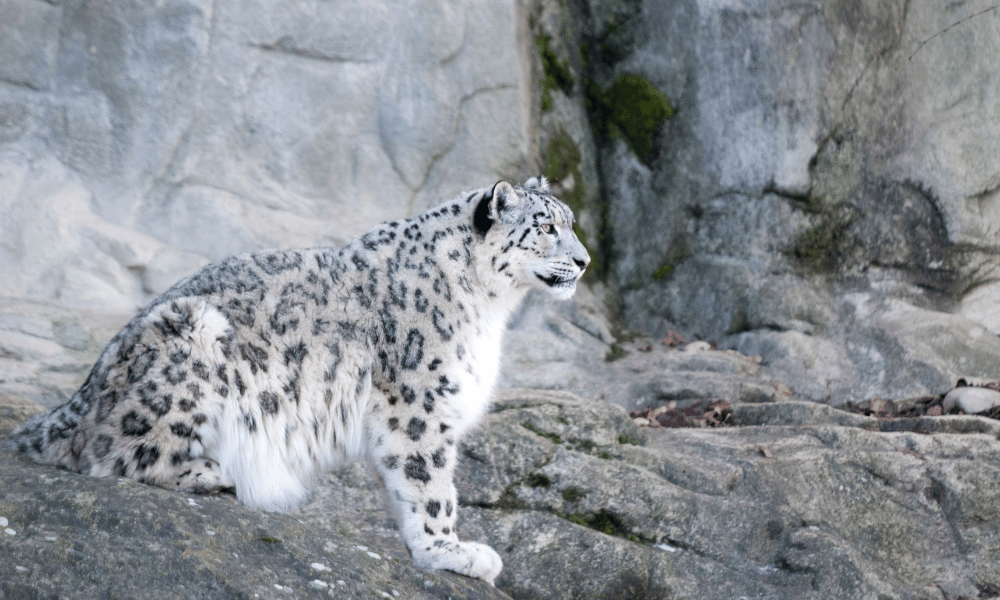
The Upper Dolpo region, known for its rugged beauty, is especially enchanting in the Manang and Nar Phu Valleys. The region, protected by the majestic Annapurna Himalayas, receives very little rainfall each year, resulting in a unique ecological environment. This land offers a symphony of natural beauty, ranging from the enchanting interspersed shrubs below 4800 meters to the hardy alpine flora above 4800 meters. In the region, the Snow Leopard shares its habitat with a variety of other animals, including golden jackals, red foxes, wolves, blue sheep, and elusive species such as the Pallas's cat, beech marten, and mountain weasel.
On your journey, you will visit Nar Phu Valley, a sanctuary that offers major habitat for the Snow Leopard. The density of six snow leopards per 100 square kilometers and a blue sheep density of eight individuals per square kilometer make it highly likely to encounter these elusive creatures. In fact, there is a remarkable 90% chance of encountering them, which is the highest probability in the country. Upper Dolpo is a remarkable destination for those interested in Snow Leopard tracking, offering a one-of-a-kind opportunity for conservation enthusiasts and advocates.
The Snow Leopard Tracking expedition in Upper Dolpo offers the opportunity to immerse oneself in a realm of rare beauty and establish a profound connection with the enigmatic vistas and wildlife. Soak yourself in the Himalayas of Nepal and embark on a journey to uncover the elusive habitat of these magnificent creatures. Observe their movements, learn from their behavior, and catch glimpses of their unique way of life. Experience the unparalleled allure that surrounds them as you delve into their world.
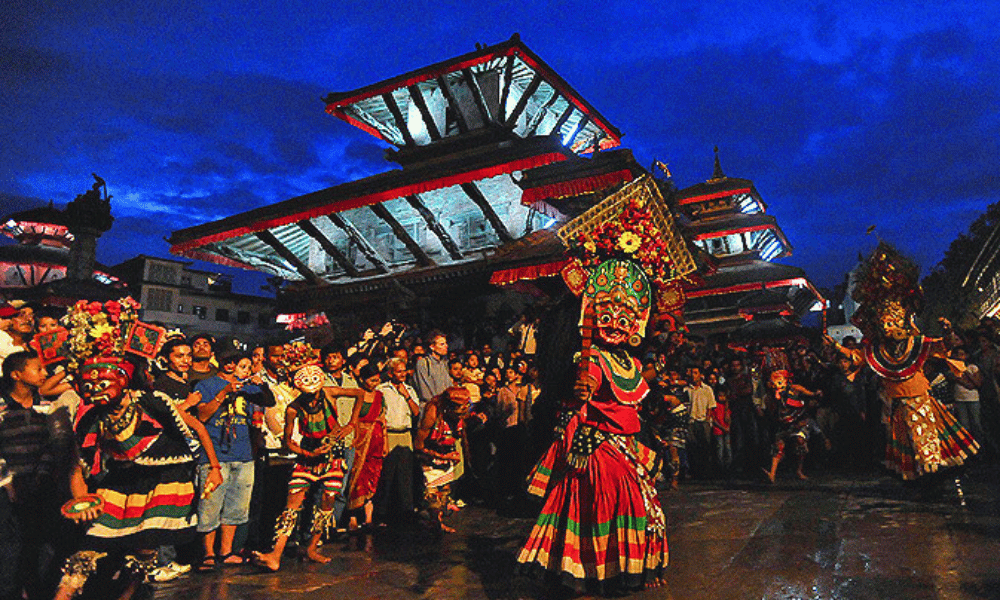
Indra Jatra, a cherished week-long festival celebrated in the Kathmandu Valley, is a mirror of the Newari community's deep-rooted culture and spirituality. Known as the "City of a Thousand Temples," Kathmandu celebrates Indra Jatra with a series of enchanting events attracting people from around the world, offering a unique glimpse into the cultural mosaic of Nepal.
The festivities commence with the majestic erection of the Kwaneya, a tall ceremonial pole (Linga) adorned with the flag of Lord Indra, taking its place at the iconic Hanuman Dhoka Durbar Square. Amidst this lively setting, a masked dancer known as Lakhey performs the classical Lakhey Nach (dance) that symbolizes his quest for the blessing of the revered Goddess Kumari, as well as the favor of Lord Ganesh, Bhairav, and Lord Indra. This ritual dance forms a bridge between the mortal realm and the divine, infusing the festival with spiritual significance.
On the third day, the living Goddess Kumari emerges from her sanctuary, Kumari Ghar, and is placed on a beautifully adorned wooden chariot. This intricately decorated chariot, resplendent with colorful fabrics, fragrant flowers, and sacred puja materials, becomes the focus of the procession. A pristine white cloth pathway is thoughtfully laid out, symbolizing the goddess's divine purity, as she is carried towards her chariot without touching the ground.
Alongside the Kumari Chariot, chariots carrying Ganesh and Bhairav, embodied by two young boys, accompany the procession, weaving through the historical Hanuman Dhoka Durbar Square. Here, vibrant mask dancers enthrall the onlookers, showcasing the rich heritage and artistic expressions of the Newari culture.
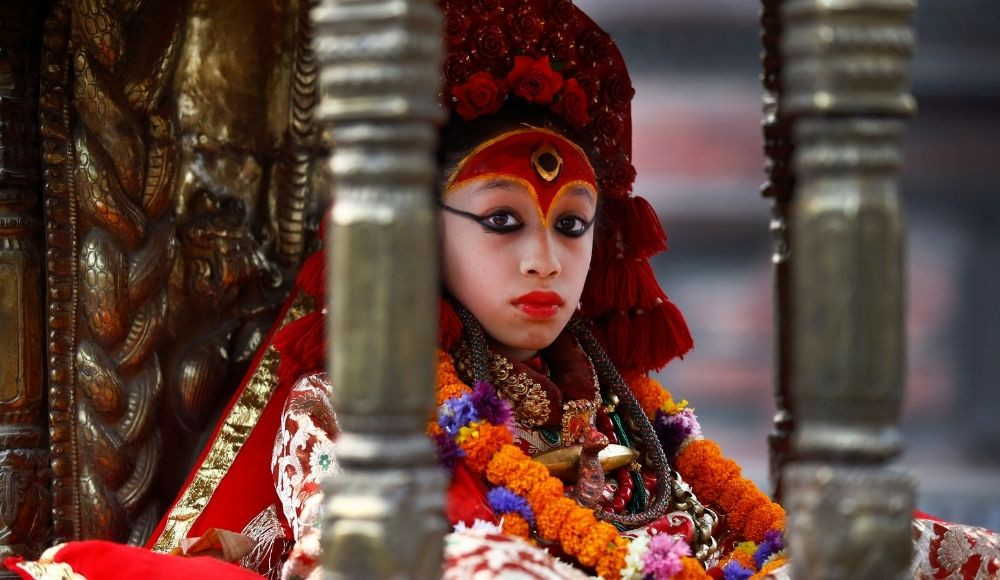
A captivating highlight of Indra Jatra is the symbolic torch-led masked dances. Among these performances, the Majipa Lakhey takes center stage, narrating a fascinating tale of tradition and transformation. This dance embodies the festival's spirit, recounting the Lakhey's evolution from a demon to the revered protector of Goddess Taleju, a narrative that resonates deeply with all who witness it.
As night falls, a magical aura blankets the temples surrounding Hanuman Dhoka Durbar Square, Indra chowk, Yetkha, and Ason. The soft glow of oil wicks and vibrant lights illuminates the Akash Bhairav temple. Nearby, a sumptuous display of Newari cuisine is presented, symbolizing fortune, prosperity, health, and longevity. This offering is sanctified by the blessings of the revered deities Kumari, Bhairav, and Ganesh.
Indra Jatra, a dynamic and significant festival, features variable dates based on the lunar calendar. Devotees, particularly farmers, express gratitude to Lord Indra for the gift of rain, while Bhairava, the vanquisher of evil, Lord Ganesh, and Kumari, the living goddess, are honored and worshipped for a good prosperous year.
Indulge in the captivating allure of Indra Jatra, a grand tribute to the gods that illuminates the heart of Kathmandu Valley. This celebration intertwines tradition, spirituality, and the enduring unity of its people, offering an unforgettable experience for all who embrace its rich cultural heritage.
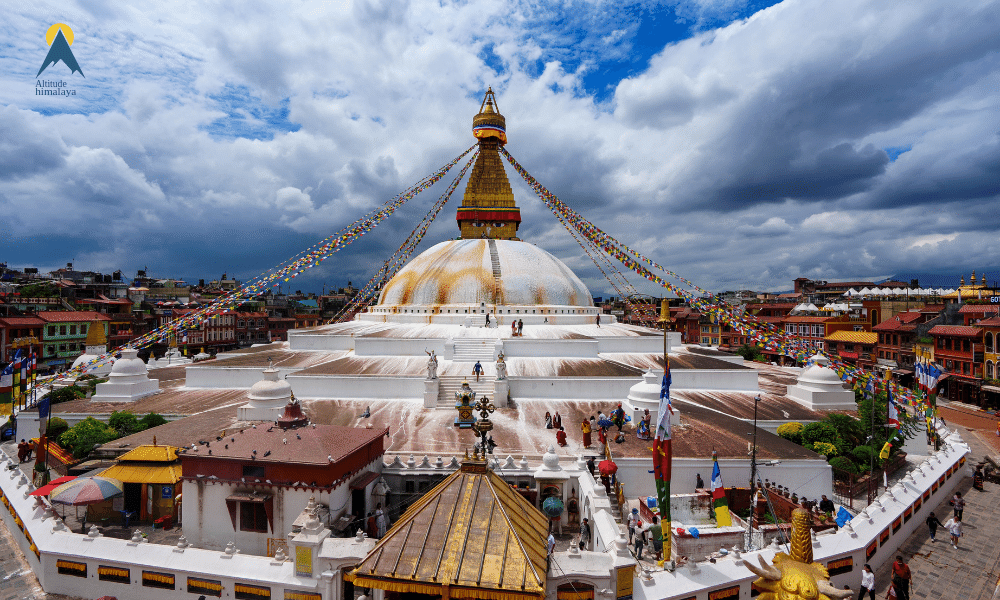
Are you giddy to go on an adventure in Nepal yet? We've got you covered with some handy tips to make your journey even more enjoyable. From savoring the local cuisine to respecting customs, here's a quick guide to help you navigate the beauty and culture of this incredible destination.
Immerse Yourself in Local Festivals: Nepal is known for its vibrant festivals. Research and plan your trip around festivals like Indra Jatra, Dashain, and Tihar to witness the rich cultural heritage and celebrations unique to each region. Be prepared for lively gatherings, colorful processions, and a chance to interact with locals during these festive times.
Savor the Diverse Cuisine: While exploring Nepal's culinary scene, venture beyond the popular dishes like momo and dal bhat. Seek out local eateries in different regions to try lesser-known specialties. Each community has its own staple dish and beverages. Embrace the variety and flavors, and don't hesitate to ask for recommendations from locals.
Prepare for High-Altitude Adventures: If you're planning on trekking or exploring high-altitude areas, acclimatization is crucial. Give yourself time to adjust, stay hydrated, and listen to your body. Consult experienced guides, who understand the altitude and can help you make the most of your trek while ensuring safety.
Respect Sacred Sites: Nepal is home to numerous religious sites, some of which hold significant cultural and spiritual importance. When visiting temples, monasteries, and other sacred places, dress modestly, remove your shoes as required, and follow any local customs. Show respect for the religious practices and the serenity of these places.
Engage with Local Communities: Nepal's diverse ethnic groups offer a chance to learn about different cultures. Interact with locals, ask questions, and participate in community activities if possible. Gain insights into their way of life, traditional arts, and customs, fostering a deeper connection with the local people.
Pack for Varied Weather Conditions: Nepal's geography can bring unpredictable weather changes. Pack versatile clothing, including layers, waterproof gear, and sturdy footwear. Depending on your activities, make sure you're prepared for both warm days and chilly nights.
Support Sustainable Tourism: Make conscious choices to support sustainable tourism practices. Choose eco-friendly accommodations, minimize single-use plastics, and shop for locally-made crafts and products. Your responsible choices can contribute to the preservation of Nepal's natural beauty and cultural heritage.
Capture the Magical Moments: Nepal offers breathtaking scenery and unique experiences. Carry a good camera or smartphone with ample storage to capture the awe-inspiring landscapes, festivals, and encounters with locals. Respect privacy, and always ask before taking photos of people.
Stay Informed: Keep up to date with the latest travel advisories and local regulations. Stay informed about any changes in festival dates, trekking routes, or entry requirements to make the most of your trip and avoid any unforeseen disruptions.
Embrace the Unexpected: Nepal is a country full of surprises, from chance encounters with wildlife during treks to impromptu celebrations you might stumble upon. Keep an open mind, be flexible with your plans, and allow the unexpected to enrich your travel experience.
As your incredible journey through Nepal draws to a close, you will find yourself immersed in a whirlwind of unforgettable moments. From the towering peaks of the Himalayas to the bustling markets of Kathmandu, this land has generously shared its most precious treasures.
We've basked in the radiant smiles of local communities, indulged in the tantalizing flavors of Nepali cuisine, and stood in awe of ancient temples that whisper stories of bygone eras. Each experience, like a brushstroke on the canvas of your memories, will paint a picture of Nepal's unique magic.
As you reflect on the diverse landscapes, the vibrant cultures, and the extraordinary encounters, you will be reminded of the richness that exists beyond your familiar horizons. Nepal has taught us the value of embracing the unfamiliar, of finding unity in diversity, and of celebrating the extraordinary in the ordinary.
Nepal, with its boundless wonders and the promise of new discoveries, will forever remain a beacon of inspiration. May the echoes of Nepal's uniqueness resonate in your future travels, reminding you that the world is a tapestry of marvels waiting to be uncovered. Until we meet again on your next expedition, let Nepal's legacy be the compass that guides you to seek out the extraordinary in every step of your voyage.
our first-hand Himalayan travel experience